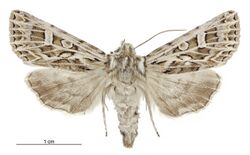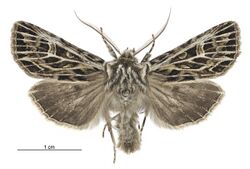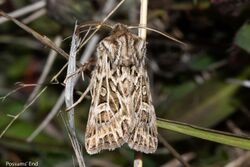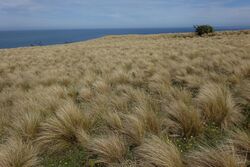Biology:Ichneutica disjungens
| Ichneutica disjungens | |
|---|---|

| |
| Female | |

| |
| Male | |
| Scientific classification | |
| Domain: | Eukaryota |
| Kingdom: | Animalia |
| Phylum: | Arthropoda |
| Class: | Insecta |
| Order: | Lepidoptera |
| Superfamily: | Noctuoidea |
| Family: | Noctuidae |
| Genus: | Ichneutica |
| Species: | I. disjungens
|
| Binomial name | |
| Ichneutica disjungens (Walker, 1858)
| |
| Synonyms[1][2] | |
| |
Ichneutica disjungens is a moth of the family Noctuidae.[3] This species is endemic to New Zealand and can be found on the central volcanic plateau of the North Island and in the eastern as well as the south western parts of the South Island. I. disjungens inhabits tussock grasslands in the alpine and subalpine zones. The hosts of the larvae of this species include Poa cita, P. colensoi, and Festuca novae-zelandiae. The adults of this species are distinctive and are unlikely to be confused with other species. They are on the wing between October and March.
Taxonomy
This species was first described by Francis Walker in 1858 using a male specimen collected by Percy Earl, likely in Waikouaiti,[4] and named Heliophobus disjungens.[5] The holotype specimen is held at the Natural History Museum, London.[1] In 1868, thinking he was describing a new species, Achille Guenée named this species Hadena nervata.[6] In 1887 Edward Meyrick synonymised that name and placed the species within the Mamestra genus.[7] J. S. Dugdale discussed this species in his 1988 catalogue and placed it within the Graphania genus.[2] In 2019 Robert Hoare undertook a major review of New Zealand Noctuidae.[1] During this review the genus Ichneutica was greatly expanded and the genus Graphania was subsumed into that genus as a synonym.[1] As a result of this review, this species is now known as Ichneutica disjungens.[1]
Description
Walker described the male of the species as follows:
Male. Cinereous, with a slight testaceous tinge, paler beneath. Fore wings with the discal part brownish fawn-colour ; lines black, undulating, irregular ; submarginal line whitish, diffuse ; veins mostly whitish ; orbicular and reniform marks with whitish and black borders; the former large, nearly round ; the latter oblong-subquadrate; exterior border dark cinereous. Hind wings pale cinereous; band and exterior border darker, under side with a blackish interior streak, connected with the blackish lunule. Length of the body 6 lines ; of the wings 14 lines.[5]
I. disjungens is a distinctive and as such is unlikely to be confused with other species.[1] The wingspan of the male of the species is between 34 and 38 mm, and for the female is between 35 and 39 mm.[1]
Distribution
This species is endemic to New Zealand.[8] In the North Island, this species has only been found in the central volcanic plateau including the Tongariro National Park.[1] In the South Island it is widespread.[1] It is found in the eastern parts of the South Island as well as south western parts of that island including Fiordland.[1]
Habitat
This species inhabits tussock grasslands found in the alpine and subalpine zones.[1]
Behaviour
This species is on the wing between October and March.[1] I. disjungens is regarded as a faster flying species and stays active despite increased wind velocities.[9] The adults of this species are attracted to light.[10]
Life history and host species
Very little is known of the life history of this species. The host species of the larvae is recorded as being tussock grasses, meaning Poa cita, Poa colensoi and Festuca novae-zelandiae.[1] Adult moths have been observed feeding on the flowers of as well as pollinating Dracophyllum acerosum.[11][12][13]
References
- ↑ 1.00 1.01 1.02 1.03 1.04 1.05 1.06 1.07 1.08 1.09 1.10 1.11 1.12 Hoare, Robert J. B. (9 December 2019). "Noctuinae (Insecta: Lepidoptera: Noctuidae) part 2: Nivetica, Ichneutica". Fauna of New Zealand 80: 1–455. doi:10.7931/J2/FNZ.80. https://www.wikidata.org/wiki/Q94481265.
- ↑ 2.0 2.1 Dugdale, J. S. (1988). "Lepidoptera - annotated catalogue, and keys to family-group taxa". Fauna of New Zealand 14: 206. https://www.landcareresearch.co.nz/__data/assets/pdf_file/0017/26324/FNZ14Dugdale1988.pdf. Retrieved 24 January 2018.
- ↑ "Ichneutica disjungens (Walker, 1858)". https://www.nzor.org.nz/names/78c6fe90-0abb-4a52-a0cf-aca5a8fd10c5.
- ↑ "A Naturalist of the very first order? Percy William Earl (1811-1846) in New Zealand". January 2013. https://www.researchgate.net/publication/259237321.
- ↑ 5.0 5.1 Gray, John Edward; Walker, Francis (1858). List of the specimens of lepidopterous insects in the collection of the British Museum. XV. London: Trustees of the British Museum. pp. 1681. doi:10.5962/bhl.title.58221. https://www.biodiversitylibrary.org/page/39337694.
- ↑ Guenée, Achille (1868). "New species, &c., of heterocerous Lepidoptera from Canterbury, New Zealand, collected by Mr. R. W. Fereday". Entomologist's Monthly Magazine 5: 1–6, 38–43, 61–65, 92–95. https://www.biodiversitylibrary.org/page/43229697.
- ↑ Meyrick, Edward (1887). "Monograph of New Zealand Noctuina". Transactions and Proceedings of the New Zealand Institute 19: 3–40. https://www.biodiversitylibrary.org/page/3301655.
- ↑ "Ichneutica disjungens". 2021. https://nztcs.org.nz/nztcs-species/47428.
- ↑ White, Graeme (1991). "The Changing Abundance of Moths in a Tussock Grassland, 1962- 1989, and 50-Year to 70-Year Trends". New Zealand Journal of Ecology 15 (1): 5–22. https://www.jstor.org/stable/pdf/24054454.pdf.
- ↑ Wood, J. (January 1973). "A list of Lepidoptera taken in light traps at Winchmore Irrigation Research Station" (in en). New Zealand Entomologist 5 (3): 284–290. doi:10.1080/00779962.1973.9723023. ISSN 0077-9962. http://www.tandfonline.com/doi/abs/10.1080/00779962.1973.9723023.
- ↑ Primack, Richard B. (July 1983). "Insect pollination in the New Zealand mountain flora" (in en). New Zealand Journal of Botany 21 (3): 317–333. doi:10.1080/0028825X.1983.10428561. ISSN 0028-825X. http://www.tandfonline.com/doi/abs/10.1080/0028825X.1983.10428561.
- ↑ , Wikidata Q54669862
- ↑ "Graphania disjungens (Walker, 1858)". 2011. https://plant-synz.landcareresearch.co.nz/ReportForm.aspx?RecordId=1583&Type=H&SortBy=Alpha&Biostatus=a,c,e,n.
Wikidata ☰ Q104172785 entry
 |



